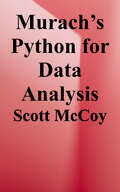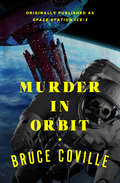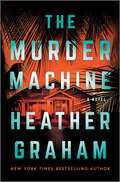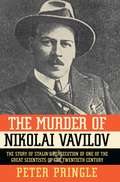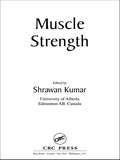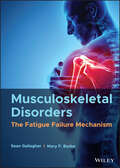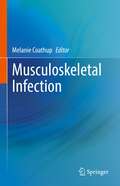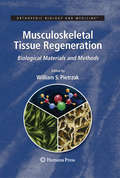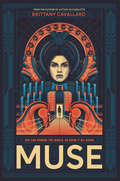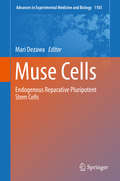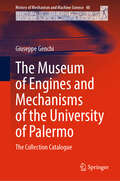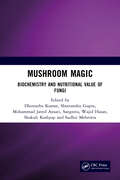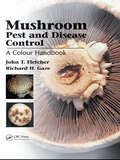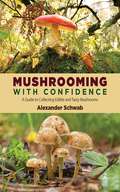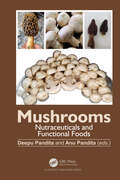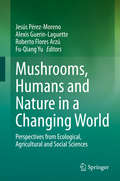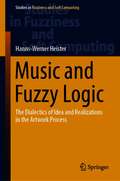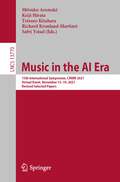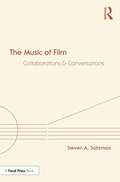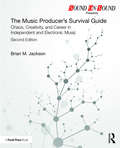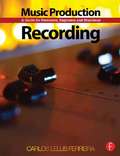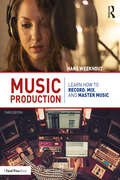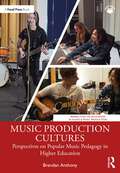- Table View
- List View
Murach's Python for Data Analysis
by Scott McCoyData is collected everywhere these days, in massive quantities. But data alone does not do you much good. That is why data analysis -- making sense of the data -- has become a must-have skill in the fields of business, science, and social science. But it is a tough skill to acquire. The concepts are challenging, and too many books and online tutorials treat only parts of the total skillset needed. <p><p>Now, though, this book draws all the essential skills together and presents them in a clear and example-packed way. So you will soon be applying your programming skills to complex data analysis problems, more easily than you ever thought possible. In terms of content, this book gets you started the right way by using Pandas for data analysis and Seaborn for data visualisation, with JupyterLab as your IDE. Then, it helps you master descriptive analysis by teaching you how to get, clean, prepare, and analyse data, including time-series data. Next, it gets you started with predictive analysis by showing you how to use linear regression models to predict unknown and future values. And to tie everything together, it gives you 4 real-world case studies that show you how to apply your new skills to political, environmental, social, and sports analysis. <p><p>At the end, you will have a solid set of the professional skills that can lead to all sorts of new career opportunities. Sound too good to be true? Download a sample chapter for free from the Murach website and see for yourself how this book can turn you into the data analyst that companies are looking for.
Murder in Orbit
by Bruce CovilleA young scientist discovers a zero-gravity homicide onboard a space station Rusty McPhee was born on Earth, but he hasn't been on solid ground for so long that he hardly remembers what it's like. He was raised on the space station known as ICE-3, and he knows the ins and outs of this floating research platform better than anybody. He's working in the waste disposal unit, watching garbage dissolve and be recycled, when he sees something terrifying: a dead body, half decomposed, face down in the muck. Before he can tell anyone what he's found, the machines finish processing the body, and he's left without any evidence that a murder ever happened. Not one of ICE-3's twenty-five thousand inhabitants is missing--so where did the body come from? As he tracks the zero-G killer, danger lurks around every airlock, and it will take just one misstep for Rusty to fall from the sky. This ebook features an illustrated personal history of Bruce Coville including rare images from the author's collection.
The Murder Machine: A Novel
by Heather GrahamArtificial intelligence meets genuine murderous intent. This state-of-the-art smart home has everything: a next-generation entertainment system, an ultramodern kitchen where every appliance is online and even a personal AI to control it all. Standing above its owner's lifeless body, FBI agent Jude Mackenzie is faced with the daunting task of discovering how the woman was killed by her own home. How do you catch a murderer that doesn't leave any fingerprints? Enter Special Agent Victoria Tennant, whose familiarity with cybercrime reveals the stark truth: a machine can only do what it's been directed to. As the number of grisly "accidents" begins to rise, the pair must race to uncover the perpetrator even as they find themselves caught in their digital crosshairs! There's nowhere to hide when danger may be as close as the very phones in their pockets.
The Murder of Nikolai Vavilov
by Peter PringleIn The Murder of Nikolai Vavilov, acclaimed journalist and author Peter Pringle recreates the extraordinary life and tragic end of one of the great scientists of the twentieth century. In a drama of love, revolution, and war that rivals Pasternak's Dr. Zhivago, Pringle tells the story of a young Russian scientist, Nikolai Vavilov, who had a dream of ending hunger and famine in the world. Vavilov's plan would use the emerging science of genetics to breed super plants that could grow anywhere, in any climate, in sandy deserts and freezing tundra, in drought and flood. He would launch botanical expeditions to find these vanishing genes, overlooked by early farmers ignorant of Mendel's laws of heredity. He called it a "mission for all humanity." To the leaders of the young Soviet state, Vavilov's dream fitted perfectly into their larger scheme for a socialist utopia. Lenin supported the adventurous Vavilov, a handsome and seductive young professor, as he became an Indiana Jones, hunting lost botanical treasures on five continents. In a former tsarist palace in what is now St. Petersburg, Vavilov built the world's first seed bank, a quarter of a million specimens, a magnificent living museum of plant diversity that was the envy of scientists everywhere and remains so today. But when Lenin died in 1924 and Stalin took over, Vavilov's dream turned into a nightmare. This son of science was from a bourgeois background, the class of society most despised and distrusted by the Bolsheviks. The new cadres of comrade scientists taunted and insulted him, and Stalin's dreaded secret police built up false charges of sabotage and espionage. Stalin's collectivization of farmland caused chaos in Soviet food production, and millions died in widespread famine. Vavilov's master plan for improving Soviet crops was designed to work over decades, not a few years, and he could not meet Stalin's impossible demands for immediate results. In Stalin's Terror of the 1930s, Russian geneticists were systematically repressed in favor of the peasant horticulturalist Trofim Lysenko, with his fraudulent claims and speculative theories. Vavilov was the most famous victim of this purge, which set back Russian biology by a generation and caused the country untold harm. He was sentenced to death, but unlike Galileo, he refused to recant his beliefs and, in the most cruel twist, this humanitarian pioneer scientist was starved to death in the gulag. Pringle uses newly opened Soviet archives, including Vavilov's secret police file, official correspondence, vivid expedition reports, previously unpublished family letters and diaries, and the reminiscences of eyewitnesses to bring us this intensely human story of a brilliant life cut short by anti-science demagogues, ideology, censorship, and political expedience.
Muscle Strength
by Shrawan KumarMuscle strength is an important topic for ergonomics practitioners and physiologists to understand, especially as it relates to workplace injuries. Muscle strength and function is at the heart of many injuries that lead to reduced productivity and economic strain on the worker, the company, and society as a whole.This comprehensive source o
Musculoskeletal Disorders: The Fatigue Failure Mechanism
by Sean Gallagher Mary F. BarbeMusculoskeletal Disorders Hands-on guidance and tools for the prevention of musculoskeletal injuries in the workplace In Musculoskeletal Disorders: The Fatigue Failure Mechanism, a team of accomplished occupational health experts delivers an essential and incisive discussion of how musculoskeletal disorders (MSDs) develop and progress, as well as how they can be prevented and controlled. Offering a novel, evidence-based approach to this costly problem, the book has broad implications for employers, insurers, and other stakeholders in workplace health and safety. The authors identify new risk assessment approaches based on the cumulative effects of exposure to highly variable loading conditions. These new approaches can also be applied to evaluate the efficacy of job rotation scenarios and to quantify exoskeleton efficacy. The complexities associated with fatigue failure in biological environments are also explored in addition to suggested models for understanding how the body maintains musculoskeletal homeostasis. Readers will also find: Thorough introductions to the material properties of musculoskeletal tissues and the fundamental principles of fatigue failure analysis In-depth explorations of the structure and function of the musculoskeletal system and up-to-date epidemiological research on MSDs Comprehensive discussions of validated fatigue failure risk assessment methods, including continuous exposure assessment to better quantify injury risk Insightful treatments of remodeling and healing processes as they apply to MSD risk, as well as factors that impair the healing process, like stress, obesity, and aging Perfect for occupational and environmental health and safety (OEHS) professionals, Musculoskeletal Disorders: The Fatigue Failure Mechanism will also earn a place in the libraries of ergonomists, physical therapists, biomechanists, industrial hygienists, occupational physicians, orthopedists, and musculoskeletal disorder researchers.
Musculoskeletal Infection
by Melanie CoathupThis book gathers international knowledge and contemporary clinical and scientific evidence on infections associated with the musculoskeletal system at a time when we are confronted with significant challenges and uncertainty. A key focus of the book is enhancing and advancing future discovery in the detection, prevention and treatment of musculoskeletal infection. This is an ideal book for physicians, surgeons, research scientists, university students, as well as medical and allied health students.
Musculoskeletal Tissue Regeneration
by William S. Pietrzak C. A. VacantiThe repair of musculoskeletal tissue is a vital concern of all surgical specialties, orthopedics and related disciplines. Written by recognized experts, this book aims to provide both basic and advanced knowledge of the newer methodologies being developed and introduced to the clinical arena. A valuable resource for researchers, developers, and clinicians, the book presents a foundation to propel the technology and integration of the current state of knowledge into the 21st century.
Muse
by Brittany CavallaroAmerican Royals meets The Winner’s Curse in the first book of a dazzling duology from New York Times bestselling author Brittany Cavallaro about revolution, love, and friendship in a reimagined American monarchy. The year is 1893, and war is brewing in the First American Kingdom. But Claire Emerson has a bigger problem. Claire’s father is a sought-after inventor, but he believes his genius is a gift granted to him by his daughter’s touch, so he keeps Claire under his control.As their province prepares for war, Claire plans to escape, even as her best friend, Beatrix, tries to convince her to stay and help with the growing resistance movement that wants to see a woman on the throne. When her father’s weapon fails to fire on the World’s Fair’s opening day, Claire is taken captive by Governor Remy Duchamp, St. Cloud’s young, untried ruler. Remy believes that Claire’s touch bestows graces he’s never had, and with political rivals planning his demise, Claire might be his only ally.The last thing that Claire has ever wanted is to be someone else’s muse, but she finally has a choice: Will she quietly remake her world from the shadows—or bring it down in flames?
Muse Cells: Endogenous Reparative Pluripotent Stem Cells (Advances in Experimental Medicine and Biology #1103)
by Mari DezawaThis book provides the first comprehensive account of multilineage-differentiating stress-enduring (Muse) cells, a pluripotent and non-tumorigenic subpopulation of mesenchymal stem cells (MSCs) that have the ability to detect damage signals, migrate to damaged sites, and spontaneously differentiate into cells compatible with the affected tissue, thereby enabling repair of all tissue types. The coverage encompasses everything from the basic properties of Muse cells to their tissue repair effects and potential clinical applications—for example, in acute myocardial infarction, stroke, skin injuries and ulcers, renal failure, and liver disease. An important technical chapter provides a practical and precise protocol for the isolation of Muse cells, which will enable readers to use Muse cells in their own research. In offering fascinating insights into the strategic organization of the body’s reparative function and explaining how full utilization of Muse cells may significantly enhance the effectiveness of MSC treatment, the book will be of high value for Ph.D. students, postdocs, basic researchers, clinical doctors, and industrial developers.
Museum Informatics: People, Information, and Technology in Museums (Routledge Studies in Library and Information Science #Vol. 2)
by Paul F. Marty Katherine Burton JonesMuseum Informatics explores the sociotechnical issues that arise when people, information, and technology interact in museums. It is designed specifically to address the many challenges faced by museums, museum professionals, and museum visitors in the information society. It examines not only applications of new technologies in museums, but how advances in information science and technology have changed the very nature of museums, both what it is to work in one, and what it is to visit one. To explore these issues, Museum Informatics offers a selection of contributed chapters, written by leading museum researchers and practitioners, each covering significant themes or concepts fundamental to the study of museum informatics and providing practical examples and detailed case studies useful for museum researchers and professionals. In this way, Museum Informatics offers a fresh perspective on the sociotechnical interactions that occur between people, information, and technology in museums, presented in a format accessible to multiple audiences, including researchers, students, museum professionals, and museum visitors.
The Museum of Engines and Mechanisms of the University of Palermo: The Collection Catalogue (History of Mechanism and Machine Science #48)
by Giuseppe GenchiThe book describes the collection of the Museum Engines and Mechanisms of the University of Palermo, Italy, one of the most important and heterogeneous collections of engines and mechanisms in Europe, the first one in Italy to be awarded as Mechanical Engineering Heritage Collection by the American Society of Mechanical Engineers. Thanks to its numerous items, this book showcases the evolution of fluid machinery and applied mechanics, from steam engines up to turbojet engines, as well as hybrid system, giving several technical and historical information about its most important engines, which are described in detail through pictures and original drawings. The Museum preserves and makes freely available this almost unique collection of more than 300 engines, didactic models, and technical equipment, including various unique exemplars, continuously enhanced thanks to donations and through restoration activities carried out in a dedicated laboratory of the Museum. As a result of a great deal of philological research carried out on the documents collected in the Museum’s archive, as well as in other institutional and corporate historical archives, this book serves as the reference tool of the collection and, more generally, of the Museum itself. Despite the technical subject and the academic environment in which it was created, the catalogue is realized to be read even by non-experts, offering different levels of detail, the first of which is the historical, economic and, in certain cases, even sporting context related to an engine, such as the vehicle for which it was designed and used.
Mushroom Magic: Biochemistry and Nutritional Value of Fungi
by Dhirendra Kumar Sheetanshu Gupta Mohammad Javed Ansari Wajid Hasan Shakuli Kashyap Sudhir MehrotraThis book presents a detailed account of mushroom biology. It covers the biochemical composition, nutritional significance, and health benefits of mushrooms. It also discusses their medicinal properties, biochemical variability, and culinary techniques for maximizing their nutritional value.The subject matter in this book also discusses: Impact of Cooking and Processing on Mushroom Nutrient Retention Vitamins and Minerals in Mushrooms: A Nutritional Treasure Chitin and Chitosan in Mushrooms: Bioactivity and Applications Allergenic and Toxic Compounds in Mushrooms: Biochemical Identification and Implications Edible and Wild Medicinal Mushrooms: Comparative Biochemical Profiles Print edition not for sale in South Asia (India, Sri Lanka, Nepal, Bangladesh, Pakistan or Bhutan)
Mushroom Pest and Disease Control: A Colour Handbook
by John T. Fletcher Richard H. GazeThe production of Agaricus bisporus is a major, world-wide, highly mechanized process. Healthy crops are essential if yields, quality and profitability are to be maintained. Pests and diseases are a major cause of crop losses and this book covers their recognition, biology and control. New pests and diseases are described together with changes in t
Mushrooming with Confidence: A Guide to Collecting Edible and Tasty Mushrooms
by Alexander SchwabPicking mushrooms in the woods on a sunny day can be fun for the whole family . . . but only if you do it safely! There are thousands of different species of fungi, so it can be hard to tell which are edible and which are poisonous when you are picking them for yourself in the wild. Safe and unsafe species often closely resemble each other, and worrying about which mushrooms are safe and which might be deadly can take all the fun out of mushrooming. Enter Mushrooming with Confidence! Improving on the usual overwhelming and exhaustive wild plant guidebook, Mushrooming with Confidence is a slim, handy manual that focuses on the tastiest and most common mushrooms, so that you can easily spot those that are not only safe to eat, but also a delight to cook and share! Here mushrooms are divided into four identification categories so that anyone will be able to recognize what he or she is looking at quickly and correctly. Thirty of the most common and delicious types are explained in detail, from the common field mushroom to the pretty purple amethyst deceiver and the prolific and tasty charcoal burner. Each mushroom includes a “Positive ID Checklist” that the reader can go through to be absolutely certain they have the right species, and more than 300 color photographs make it a snap to know exactly what kind of mushroom you’ve found . . . and whether you really want to pick it! With lists of the best tools for mushrooming, the best techniques for getting a mushroom out of the ground in one piece, and even how to remove worms, Mushrooming with Confidence will extinguish any fear or doubt that might stop you from hunting down your own delicious mushrooms. This will prove a fun and essential guide for novice and experienced pickers alike!
Mushrooms: Nutraceuticals and Functional Foods
by Deepu Pandita Anu PanditaThere are around 1.5 million fungal species worldwide. Out of these around 14,000 species produce fruiting bodies known as mushrooms, and around 2000 species are edible, and only 270 are reported to be medicinal. The fungal kingdom is phylogenetically closer to humans than plants, so gives better health benefits to human systems. This book educates readers on the nutritional, pharmaceutical and medicinal values of different mushrooms and their utilization as nutraceuticals and functional foods for human security. It reviews the current knowledge on the distribution of edible mushrooms, its general characteristics, morphology, nutritional profile and properties, pharmacological importance, and biological activities. Health benefits of mushrooms, antioxidant and secondary metabolite profiling, major biological activities of mushroom-derived secondary metabolites, functional foods based on the mushrooms open doors for therapies, products with added value, toxicology, and side effects if any are also highlighted. The book is intended for a large and varied audience – researchers, scientists, and scholars in academia, mushroom growers and industries, nutritionists, dietitians, food scientists, clinicians, doctors, drug industries, pharmacy, biotechnologists, biochemists, botanists, mycologists, and general masses.
Mushrooms, Humans and Nature in a Changing World: Perspectives from Ecological, Agricultural and Social Sciences
by Jesús Pérez-Moreno Alexis Guerin-Laguette Roberto Flores Arzú Fu-Qiang YuThis book focuses on recent advances in our understanding of wild edible mycorrhizal fungi, truffle and mushrooms and their cultivation. In addition to providing fresh insights into various topics, e.g. taxonomy, ecology, cultivation and environmental impact, it also demonstrates the clear but fragile link between wild edible mushrooms and human societies. Comprising 17 chapters written by 41 experts from 13 countries on four continents, it enables readers to grasp the importance of protecting this unique, invaluable, renewable resource in the context of climate change and unprecedented biodiversity loss. The book inspires professionals and encourages young researchers to enter this field to develop the sustainable use of wild edible mushrooms using modern tools and approaches. It also highlights the importance of protecting forested environments, saving species from extinction and generating a significant income for local populations, while keeping alive and renewing the link between humans and wild edible mushrooms so that in the future, the sustainable farming and use of edible mycorrhizal mushrooms will play a predominant role in the management and preservation of forested lands.
Music and Fuzzy Logic: The Dialectics of Idea and Realizations in the Artwork Process (Studies in Fuzziness and Soft Computing #406)
by Hanns-Werner HeisterThis book unfolds the manifold, complex and intertwined relations between Fuzzy Logic and music in a first comprehensive overview on this topic: systematically as an outline, as completely as possible, in the aspects of Fuzzy Logic in this relation, and especially in music as a process with three main phases, five anthropological layers, and thirteen forms of existence of the art work (Classics, Jazz, Pop, Folklore). Being concerned with the ontological, gnoseological, psychological, and (music-) aesthetical status and the relative importance of different phenomena of relationship between music and Fuzzy Logic, the explication follows the four main principles (with five phenotypes) of Fuzzy Logic with respect to music: similarity, sharpening 1 as filtering, sharpening 2 as crystallization, blurring, and variation. The book reports on years of author’s research on topics that have been only little explored so far in the area of Music and Fuzzy Logic. It merges concepts of music analysis with fuzzy logical modes of thinking, in a unique way that is expected to attract both specialists of music and specialists of Fuzzy Logic, and also non-specialists in both fields. The book introduces the concept of dialectic between sharpening and – conscious – “blurring”. In turn, some important aspects of this dialectic are discussed, placing them in an historical dimension, and ending in the postulation of a 'musical turn' in the sciences, with some important reflections concerning a “Philosophy of Fuzzy Logic”. Moreover, a production-oriented thinking is borrowed from fuzzy logic to musicology in this book, opening new perspectives in music, and possibly also in other artistic fields.
Music and Human-Computer Interaction
by Katie Wilkie Allan Seago Paul Mulholland Simon HollandThis agenda-setting book presents state of the art research in Music and Human-Computer Interaction (also known as 'Music Interaction'). Music Interaction research is at an exciting and formative stage. Topics discussed include interactive music systems, digital and virtual musical instruments, theories, methodologies and technologies for Music Interaction. Musical activities covered include composition, performance, improvisation, analysis, live coding, and collaborative music making. Innovative approaches to existing musical activities are explored, as well as tools that make new kinds of musical activity possible. Music and Human-Computer Interaction is stimulating reading for professionals and enthusiasts alike: researchers, musicians, interactive music system designers, music software developers, educators, and those seeking deeper involvement in music interaction. It presents the very latest research, discusses fundamental ideas, and identifies key issues and directions for future work.
Music in the AI Era: 15th International Symposium, CMMR 2021, Virtual Event, November 15–19, 2021, Revised Selected Papers (Lecture Notes in Computer Science #13770)
by Mitsuko Aramaki Keiji Hirata Tetsuro Kitahara Richard Kronland-Martinet Sølvi YstadThis book constitutes the refereed proceedings and revised selected papers from the 15th International Symposium on Music in the AI Era, CMMR 2021, which took place during November 15–19, 2021 as a virtual event. The 24 full papers included in this book were carefully reviewed and selected from 48 submissions. The papers are grouped in thematical sessions on Music technology in the IA era; Interactive systems for music; Music Information Retrieval and Modeling; and Music and Performance Analysis.
The Music of Film: Collaborations and Conversations
by Steven A. SaltzmanThe Music of Film opens up the world of film music from the inside. Through a series of interviews and conversations with professional composers, music supervisors, music editors, and picture editors, this book shows how music for film and television works according to insiders in the industry. Here we find a comprehensive collection of techniques and personal insights and get a unique perspective on how these key players in postproduction interact, collaborate, and successfully build their careers. The Music of Film is essential reading for composers, editors, directors, and producers—aspiring and established alike—or anyone interested in learning how to start or manage a profession working with music in feature films, television, and other media.
The Music Producer’s Survival Guide: Chaos, Creativity, and Career in Independent and Electronic Music (Sound On Sound Presents...)
by Brian M. JacksonA music-career book like no other, The Music Producer’s Survival Guide offers a wide-ranging, exploratory, yet refreshing down-to-earth take on living the life of the independent electronic music producer. If you are an intellectually curious musician/producer eager to make your mark in today’s technologically advanced music business, you’re in for a treat. This new edition includes industry and technological updates, additional interviews, and tips about personal finances, income, and budgets. In this friendly, philosophical take on the art and science of music production, veteran producer, engineer, and teacher Brian Jackson shares clear, practical advice about shaping your own career in today’s computer-centric "home-studio" music world. You’ll cover music technology, philosophy of music production, career planning, networking, craft and creativity, the DIY ethos, lifestyle considerations, and much more. Brian’s thoughtful approach will teach you to integrate your creative passion, your lifestyle, and your technical know-how. The Music Producer’s Survival Guide is the first music-production book to consider the influence of complexity studies and chaos theory on music-making and career development. It focuses on practicality while traversing a wide spectrum of topics, including essential creative process techniques, the TR-808, the proliferation of presets, the butterfly effect, granular synthesis, harmonic ratios, altered states, fractal patterns, the dynamics of genre evolution, and much more. Carving out your niche in music today is an invigorating challenge that will test all your skills and capacities. Learn to survive—and thrive—as a creative-technical professional in today’s music business, with the help of Brian Jackson and The Music Producer’s Survival Guide!
Music Production: A Guide for Producers, Engineers, and Musicians
by Carlos LellisYour recording can make or break a record, and a clean recording is an essential catalyst for a record deal. Professional engineers with exceptional skills can earn vast amounts of money be in demand from the biggest acts. To develop such skills you need to master both the art and science of recording. Rehearsal to Monitor Mix gives you all you need to know, the tools and techniques, to put into practice and improve your recording. Covering the entire process from fundamental concepts to advanced techniques and offering a multitude of tips and tricks and audio samples, this book has it all.Carlos Lellis teaches you , how to craft and evaluate your recording then take it a step further. He describes the theory and the tools used how these are put into practice and then shows you how they are put together. Using audio and visual materials and field observations to aid with explanationsPacked full of photos, graphs, diagrams and audio samples, Rehearsal to Monitor Mix is a vital read for anyone wanting to succeed in the field of recording
Music Production: Learn How to Record, Mix, and Master Music
by Hans WeekhoutWe’re all able to record music; a smartphone will get you quick results. But for a good sound, a lot more is involved. Acoustics, microphone placement, and effects have a huge influence on the resulting sound. Music Production: Learn How to Record, Mix, and Master Music will teach you how to record, mix, and master music. With accessible language for both beginner and advanced readers, the book contains countless illustrations, includes tips and tricks for all the popular digital audio workstations and provides coverage of common plugins and processors. Also included is a section dedicated to mastering in a home studio. With hundreds of tips and techniques for both the starting and advanced music producer, this is your must-have guide.
Music Production Cultures: Perspectives on Popular Music Pedagogy in Higher Education (Perspectives on Education in Audio & Music Production)
by Brendan AnthonyMusic Production Cultures draws on interviews with international educators, surveys completed by students of music production from around the globe, doctoral research findings and contextualised career experiences from the author as a celebrated music producer to explore how effective learning environments can be created for popular music production in higher education. Acknowledging the musical, technological and social diversity in global popular music production practice, this book highlights the integral elements that educators and their institutions must consider in order to provide high-quality and relevant education for the students of today and into the future. Offering concepts, approaches and practices to be integrated into diverse music production pedagogical frameworks in higher education, this book considers the pedagogical approaches and goals that bridge music production education to the industry, using examples and insights from international educators throughout as well as lesson plan examples for instructors. Music Production Cultures develops a foundation of practice to inform teachers designing equitable, diverse and inclusive pedagogies that are dependent on the musical, cultural and social influences of their students. This is an invaluable resource for educators and researchers in the area of audio education looking to develop their pedagogical strategies.
